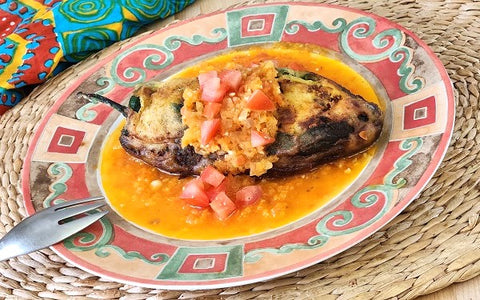Vegetarian Soyrizo Chile Relleno
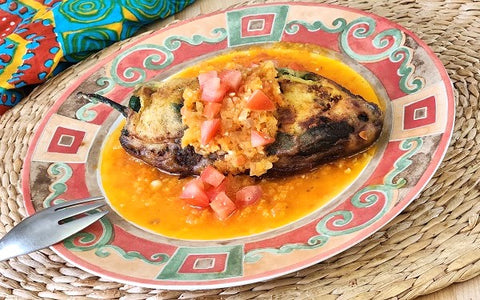
Over half of the U.S. adult population, some 154 million, qualify as being overweight or obese. Another 29 million of us have Diabetes, many as a direct result of being overweight. Then there are the 23.9 million overweight children who are dutifully following the example of their XXL adult role models. Diabetes and these extra pounds cost this country billions annually in both medical and economic resources; not to mention the effect these weight-related maladies have on a person’s overall mental well-being and happiness. However, both diabetes and being overweight are very manageable, even preventable, with a few lifestyle tweaks. By maintaining a sensible diet in conjunction with some consistent exercise, no matter how minimal, we can all be in total control of our own weight. One easy way to start taking that control is to make decisions about the foods we eat based on the glycemic index [GI] and glycemic load [GL].
Simply put, our bodies convert all foods into sugar calories that provide energy to the body via the blood stream. The Glycemic Index assigns a score of 1 to 100 to all foods based how speedy the body converts that food into sugar. Foods that break down slowly enable the body to assimilate theses calories of energy more efficiently without overwhelming the body with more sugar than it can process. While this is especially important for diabetics who process sugars much slower than others, everyone can benefit from eating foods that have low glycemic scores since they also reduce appetite and encourage the metabolism to burn body fat. Conversely, a diet of foods high on the glycemic charts have been proven to actually increase appetite and impede effective fat oxidation.
A QUICKIE GLYCEMIC PRIMER:
- The glycemic index of a food compares its effect on blood sugar level to that of pure glucose, which has a score of 100. White breads, which are made of processed white flour, are at the top of this scale, scoring a “perfect” 100 on the glycemic index. For perspective, a score of 55 or below denotes a low glycemic index food; 70 or above is considered very high. Serving size is not a consideration in arriving at a food’s Glycemic Index number.
- The glycemic load, on the other hand, focuses on how much digestible carbohydrates (sugars) a food contains in a typical single serving, which is defined as approximately 3.5 ounces. For glycemic load, a score of 20 or more is high, while 10 or less is low.
One of my favorites was and still is the Chile Relleno, though this traditional dish needed a complete makeover to continue to be enjoyed when I started counting carbs. While the main ingredient—a fresh chile pepper— is perfectly healthy, this dish is anything but, especially when ordered at a Taqueria. The pepper is usually stuffed with a Mexican cheese that is super high in sodium; sometimes chorizo sausage is also added, then it’s coated in a white flour batter and deep-fried in corn oil or, more traditionally, flavorful lard. Then it’s smothered in sauce plus more melted salty cheese. And if that doesn’t give a giant boost to blood sugars, the dish is usually served with a side of tortillas, rice and refried beans!
These Chile Rellenos are low in carbs but high in flavor! Poblano peppers have a rich, smoky taste with just a touch of heat. Stuffed with Melissa’s spicy Soyrizo Sausage and a small measure of cheddar cheese, then coated in a lighter-than-air egg batter that looks and tastes just like the “real” thing, only healthier! Replace the melted cheese over the top with seasoned fresh tomato sauce and your Cinco celebration can be deliciously glycemic-friendly!
This recipe is just another great way (insert: excuse) to incorporate Soyrizo into a dish! This product has saved lives! OK, maybe that’s a bit of a hyperbole, though technically true for us chorizo-heads with no willpower. That is, most of us would have probably continued to chow down on what we knew to be a completely unhealthy, utterly delicious sausage product if Soyrizo had not come along! The secret is in replicating the unique combination of seasonings of the original sausage in a soy product that passes the taste-like-chorizo blindfold test. Soyrizo is truly a rare successful facsimile that is only missing the artery-clogging bad stuff of its sausage counterpart.
The flour batter had to go too. Coconut flour contains 68.7 grams of carbohydrate per 100 grams. Of that 38.5 grams is dietary fiber, sugar accounts for another 8.7 grams leaving about 17.6 grams of starchy carbs. On the other hand, 100 grams all-purpose flour contains 76.3 grams of total carbs. Of that total carbs only 2.7 grams are from dietary fiber and another 0.3 grams from sugar leaving 73.3 grams of total carbohydrates! The result is a lighter-than-air batter that would be unfair to compare with the much denser white flour option.
So, with a couple of sensible ingredient tweaks, you too can celebrate Cinco de Mayo with glycemic gusto! Maybe even break out your most colorful serape for the occasion!
Soyrizo Chile Relleno
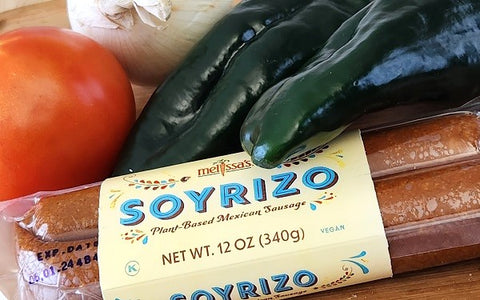
4 whole Poblano chile peppers
1 tomato, fine diced (garnish)
Filling
1 pkg Melissa’s Soyrizo, 12 oz.
½ tablespoon white vinegar
4 ounces cheddar cheese, grated
Sauce
2 tablespoons onion, minced
2 fresh tomatoes, seeded and chopped
¼ cup chicken broth
1 bay leaf
1 clove garlic
½ teaspoon oregano
salt and pepper to taste
Batter
2 large eggs, separated
¼ cup coconut flour
½ tablespoon cornstarch (or arrowroot powder)
Canola oil for frying (just enough to coat pan/avoid deep fry)
Preparation


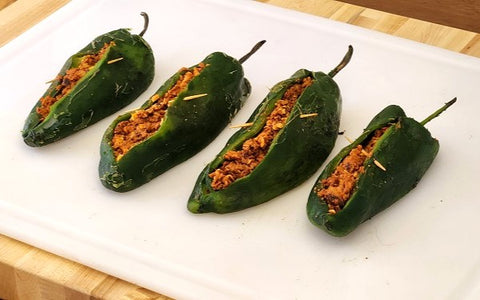
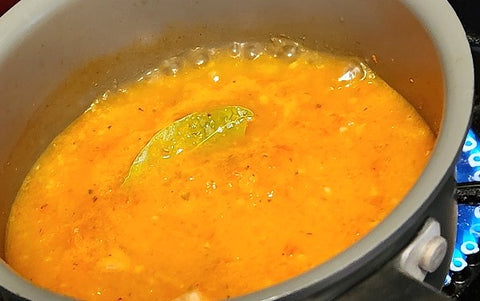
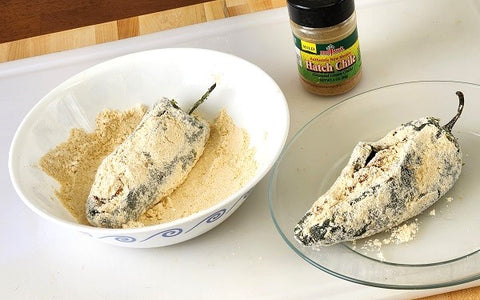


Generously coat a frying pan with oil. Put the tip of a wooden spoon or chopstick in the hot oil. When little bubbles form, the oil is ready for the chiles. Dip a chile in the whipped eggs and cover completely. Cook until golden brown on both sides.
